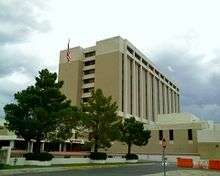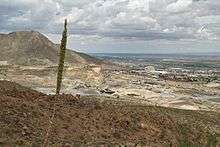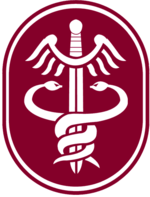William Beaumont Army Medical Center
| William Beaumont Army Medical Center | |
|---|---|
|
The WBAMC Distinctive Unit Insignia | |
| Active | 2 July 1921 – present |
| Country | United States |
| Allegiance | United States |
| Branch | United States Army |
| Type | Hospital |
| Role |
Inpatient and Outpatient Services Graduate Medical Education Level III Trauma Center |
| Size | over 150 beds |
| Garrison/HQ | Fort Bliss |
| Motto(s) | "First to Care” |
| Commanders | |
| Current commander | COL Michael S. Heimall |
| Notable commanders | Maj. Gen. (Dr.) Charles C. Pixley |
| William Beaumont Army Medical Center | |
|---|---|
 | |
 | |
| Geography | |
| Location | 5005 North Piedras St., El Paso, Texas, United States |
| Coordinates | 31°49′18″N 106°27′44″W / 31.8216°N 106.4623°WCoordinates: 31°49′18″N 106°27′44″W / 31.8216°N 106.4623°W |
| Organization | |
| Care system | Military |
| Hospital type | General |
| Affiliated university | Paul L. Foster School of Medicine |
| Services | |
| Emergency department | Level III Trauma Center |
| History | |
| Founded | 1850's |
| Links | |
| Website |
www |
| Lists | Hospitals in Texas |



William Beaumont Army Medical Center is a Department of Defense medical facility located in El Paso, Texas. It provides comprehensive care to all beneficiaries including active duty military, their family members, and retirees. The hospital is located in the Central/Northeastern part of El Paso. At present, WBAMC is the closest hospital to the Northeast, and provides billable emergency room services for Northeast El Paso. The hospital itself is very large, and contains a rather sizable Veterans Affairs Office for former military members who are in need of medical treatment.
The William Beaumont Army Medical Center (WBAMC) is one of the many health care institutions affiliated with the Paul L. Foster School of Medicine which is also located in El Paso, Texas.[1] WBAMC is also a participating hospital for medical residents from the Uniformed Services University of the Health Sciences (USU), Bethesda, MD. The current commander of WBAMC is Colonel Michael S. Heimall.
WBAMC is named for Army surgeon William Beaumont (1785-1853), the "Father of Gastric Physiology".[2]
The buildings from the "Old Fort Bliss" to include the Fort Bliss Fort Hospital (1893) were added to the National Register of Historic Places on February 23, 1972.[3]
History
The William Beaumont Army Medical Center (WBAMC), formerly the William Beaumont General Hospital (WBGH), is situated northwest of Fort Bliss’ main cantonment area, between Fred Wilson Road and Hayes Avenue. The hospital has its beginnings in Fort Bliss during the 1850s. After several earlier moves, Fort Bliss moved to its permanent location at Lanoria Mesa in 1893 and Building 8 (now the Fort Bliss Inspector General's Office) became the hospital. In 1916, the hospital moved to Building 1 (presently the Fort Bliss Directorate of Resource Management).
The construction of WBGH’s 48 buildings in 1920-21 signaled the beginning of Fort Bliss’s role as a major military medical center. Over the next two decades WBGH served as both Fort Bliss’s station hospital and as a general hospital for the western portion of the Army’s 8th Service Command. The hospital made of tile and stucco opened July 2, 1921, with a bed capacity for 403 patients.On staff were six medical officers, two nurses and 30 medical corpsmen.
During World War II, WBGH expanded to include 174 buildings and a crowded 4,064 beds. This included the 1,000 beds at Building 1 and another 750 beds at Biggs Air Force Base, now Biggs Army Air Field. Its capabilities also expanded as the hospital began providing specialized medical care to wounded soldiers returning from all theaters of the war. In December 1943, the plastic surgery clinic was opened.
During early 1945, approximately 6,000 inpatients were treated. In addition, a military school for medical technicians offered specialized training in surgical, dental, laboratory, X-ray, pharmacy and veterinary procedures. The hospital had a fully equipped physical therapy and occupational therapy center. Also, the artificial eye clinic was opened. Later, the hospital expanded into a neuro-psychiatric treatment and orthopedic surgery center. Following the war, WBGH continued to serve the medical needs of Fort Bliss and surrounding military installations until the Army’s needs outgrew the capacity of the hospital.
Maj. Gen. (Dr.) Charles C. Pixley, the hospital commander from September 1975 through December 1976, was promoted to lieutenant general in 1977 and became the Surgeon General of the Army.
In 1969, the Army began construction of a new, 12-story hospital to the west of the WBGH area. Completed in 1972, the new facility became known as the William Beaumont Army Medical Center. Although designed for 611 beds, by the early 1980s the hospital had a capacity of 463. The Omar N. Bradley building, an addition to the west-side of the main hospital, was opened in 1982. This facility provides an additional 200,000 square feet (19,000 m2) of clinical and administrative space. Today, the hospital has a bed capacity for more than 150 patients. However, during contingencies, the hospital can expand for 373 patients. As the Southwest’s major regional Army medical center, this modern facility now provides medical care to active and retired military personnel and their dependents in the three-state region of Texas, New Mexico, and Arizona.
November 1995, WBAMC became one of the largest buildings in El Paso with another 254,000 square feet (23,600 m2) of floor space for the Department of Veterans Affairs Health Care Center. Now, the WBAMC complex has more than one million square feet of floor space for patient care and administrative duties.[4]
Commanding Officers
| Dates | Name |
|---|---|
| Jul 1921 – Sep 1922 | COL William R. Eastman |
| Sep 1922 – May 1927 | COL M. A. W. Shockley |
| May 1927 – Apr 1928 | COL Reuben Miller |
| Apr 1928 – Jul 1931 | COL William H. Moncrief |
| Jul 1931 – May 1937 | COL Henry F. Pipes |
| May 1937 – Sep 1945 | COL George M. Edwards |
| Oct 1945 – Nov 1948 | COL George W. Reyer |
| Nov 1948 – Sep 1951 | COL James E. Yarbrough |
| Sep 1951 – Nov 1952 | COL Walter C. Royals |
| Jan 1953 – Apr 1957 | COL Abner Zehm |
| May 1957 – Sep 1958 | BG L. Holmes Ginn Jr. |
| Sep 1958 – Dec 1960 | BG Clinton S. Lyter |
| Dec 1960 – Mar 1965 | BG James B. Stapleton |
| Mar 1965 – Mar 1966 | MG Robert E. Blount |
| Mar 1966 – Aug 1967 | BG Frederick J. Hughes Jr. |
| Aug 1967 – Jul 1968 | BG James A. Wier |
| Jul 1968 – Jul 1970 | MG Kenneth D. Orr |
| Jul 1970 – Aug 1975 | BG Robert M. Hardaway III |
| Sep 1975 – Dec 1976 | MG Charles C. Pixley, Later became Surgeon General of the Army |
| Dec 1976 – Jun 1979 | MG Raymond H. Bishop Jr. |
| Jul 1979 – Jul 1980 | BG Kenneth A. Cass |
| Aug 1980 – Nov 1982 | BG Chester L. Ward |
| Jan 1983 – Jul 1986 | BG John E. Major |
| Jul 1986 – Sep 1988 | BG Richard D. Cameron |
| Sep 1988 – Jul 1991 | BG Richard Proctor |
| Jul 1991 – Jan 1992 | COL Preston B. Cannady |
| Jan 1992 – Dec 1994 | BG James J. James |
| Dec 1994 – Jul 1995 | COL Thomas J. Scully |
| Jul 1995 – Mar 1997 | BG Ogden Dewitt |
| Mar 1997 – Mar 1998 | BG Nancy R. Adams |
| Mar 1998 – Jul 2000 | COL David B. Crandall |
| Jul 2000 – Jul 2002 | COL Carla G. Hawley – Bowland |
| Jul 2002 – Jul 2004 | COL Glenn W. Mitchell |
| Jul 2004 – Jul 2006 | COL James J. Leech |
| Jul 2006 – May 2008 | COL John Powell |
See also
References
- ↑ http://www.ttuhsc.edu/fostersom/gme/
- ↑ William Beaumont (1833) Experiments and Observations on the Gastric Juice, Plattsburgh, New York
- ↑ National Register of Historic Places; Record Number 363574; http://www.nps.gov/nr
- ↑ History from official WBAMC webpage
External links
- William Beaumont Army Medical Center, official website
- Paul L. Foster School of Medicine
- William Beaumont Army Medical Center on Facebook
This article contains information that originally came from US Government publications and websites and is in the public domain.
